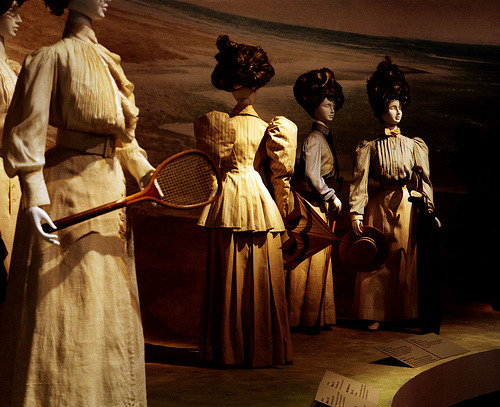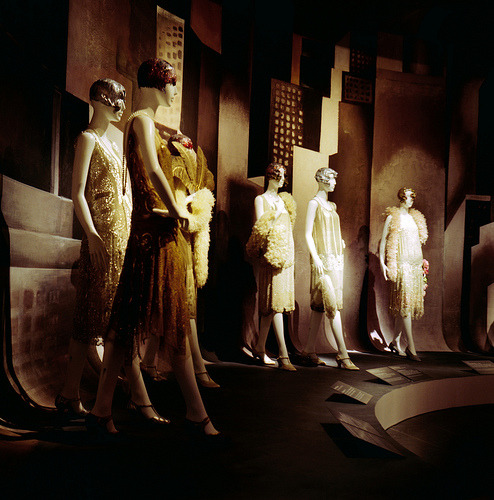The inspiration for this blog came from a recent visit to the Metropolitan Museum of Art’s American Woman: Fashioning a National Identity exhibit. This costume exhibit explores women’s fashion between 1890 and 1940, setting in motion the evolution of “today’s American woman.” The takeaway: How far have we as women removed ourselves from the ability to dress?
Ladies, what happened? I asked my mom this very question and her response? “Casual Fridays.” I’m not 100 percent convinced that this is the problem, but I was taken aback by the casualness I see on the other six days of the week, and thought that maybe, just maybe, casual Friday was the trigger.
My first job out of college was retail. In retail, there is never a casual day. And, the only denim allowed was in the form of a jacket. Jeans, never!
My first corporate job was when I experienced a more casual business environment. Corporate America, to me, was business attire to the fullest. I watched my dad wear a suit and tie to work every day. He walked out the door with high shine shoes and a briefcase. Knowing that my job was in a call center, I “dressed down” for my first day. I walked through the doors dressed in my black wool trousers, a black turtleneck, and a hand-knit sweater in black with muted tones of camel and olive green. In the days that followed, my outfits were just as pulled together.
At the end of my first week, I was told about an upcoming designated “jeans day.” Jeans day? Who wears jeans to work? That was unheard of in my retail job! I knew I wasn’t going to participate, but I asked a coworker if people truly wore jeans to work. She replied, “Yes. I save my best flannel for jeans day.” There you have it. My mom could be on the right track. Casual Fridays, especially jeans days, could be the demise of our willingness to “dress” every day.
While walking through the exhibit at the MET, I was in awe of the attire women wore for everyday activities. They engaged in sporting activities such as horseback riding, tennis, cycling, and sunbathing—all while wearing materials of leather, wool and silk. Traditional materials of cotton and linen were used as well. In the late 1800s and early 1900s, all of the collections consisted of long-sleeved jackets and ankle-length skirts. Bathing suits consisted of short-sleeved, nautical-inspired tops with matching skirts that fell just below the knee. The things I loved most of the exhibit were the exaggerated puffed sleeves that fell to the elbow, belts used to cinch the waist, and fitted jackets with peplums.


This was nothing compared to evening attire! It all began with ball gowns, which is to be expected of earlier eras. Funny thing: the full-behind bustles placed just below the waist. Women today do everything they can to disguise a large backside, but not the women of the late 1800s! Bustles sat high on the back of all the gowns displayed. The trend of dresses that fell to the ankle or longer continued through the next decades, but the décolletage was now being exposed. Gowns took a more dramatic, draping approach with capes and flowing coats. The Roaring Twenties brought higher hemlines and exposed shoulders that kept the silhouette boxy. All the details related to these costumes were impeccable; sequins, rhinestones, fringe, fur—all personal to each piece designed.

The last room of the exhibit combined gowns from early 1900s to mid-1970s, all worthy of red carpet season. Draped, loose fabrics falling freely from the waist. Intricate gathers around the bust-line. Accordion pleats. Cutouts along the back, sleeves, and bust. Examples we see today: Carrie Underwood’s gown from the 2009 Grammy Awards designed by Zuhair Murad. Angelina Jolie is infamous for wearing these vintage-inspired gowns, with the white Marc Bouwer gown from the 2004 Academy Awards being a prime example.


With the birth of Sex and the City, we saw a resurgence of the ability to dress on the small screen. Carrie Bradshaw paved the way for high heels and no-holds-barred creations, while Charlotte York gave us a glimpse back in time with her spin on 1950s prep. The Devil Wears Prada is another example of watching Corporate American women dress for the jobs they wanted. Why does it have to stop there, ladies? Why can’t we take those examples from both the small and big screen and adopt them into our daily ensembles? Take pride in your appearance. Stop wearing those all-cotton chinos and spring for a trouser made of a cotton and spandex mix. If you have to wear jeans, go for a polished denim pant. They look smart and wear well.
There are so many small things you can do to update your daily wardrobe. It doesn’t have to cost a lot of money, it doesn’t require a new wardrobe, and it will take you from business casual to Corporate America chic. If you’re interested in finding out how, stay tuned!
Photo Credits:
Photos of the MET exhibit taken from the MET’s flicker collection. Photographs by Alex Hills.
Photo of Carrie Underwood taken from pinqueblog.com. Photograph by Just Jared.
Photo of Angelina Jolie taken from moviefone.com. Photograph by Steve Granitz, WireImage.

No comments:
Post a Comment